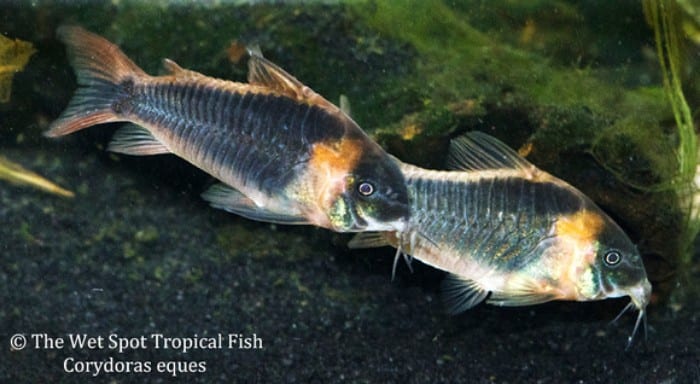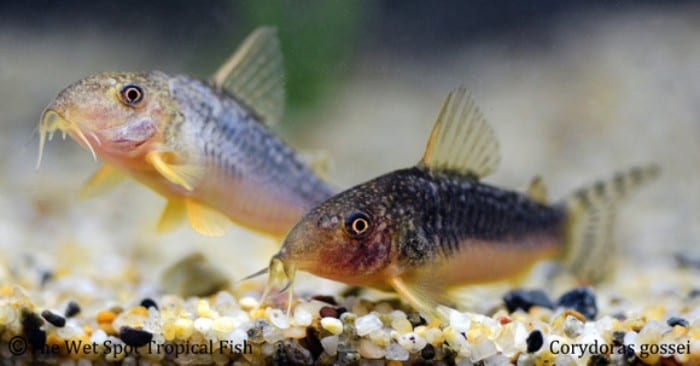Chorus of Cories
Chorus of Cories
At the Wet Spot, we specialize in rare and exotic cichlid species for the seasoned aquarist. There are some fish, however, we can’t get enough of, and always have room for in our tanks. Small, armored catfish from the genus Corydoras fit that bill perfectly. Peaceful and gregarious, a group of 4-6 cories can be added to any community tank. Their armored bodies, whiskers, and bottom dwelling behaviors make them incredibly lovable, and the perfect accent to your beautifully curated setups. While we sell around 50 different species and varieties of cories, we think you’ll find Corydoras melini, Corydoras eques, and Corydoras gossei of particular interest.
Scientific NameCorydoras melini
Common NameFalse Bandit Cory
Temperature / pH68 to 79°F / 6.0 to 8.0 pH
Native LocationBrazil
Preferred DietSinking foods
Stealing across sandy bottoms of organically stained tributaries, is C. melini. More commonly known as the “False Bandit Cory”, these fish have pale armored bodies with a thin, black, mask-like markings around their eyes, and a thin black stripe down their dorsal spine. These cories inhabit only the most pristine blackwater habitats and flooded forests of the Rio Orinoco and the Amazon River basins of Northwestern Brazil. To mimic these conditions, furnish your tank with soft sandy substrate, driftwood, twigs, and leaf litter under low light. Other furnishing is up to personal choice, though your bandits will be grateful for safe zones in the tank with cover. These cories are also opportunistic omnivores, and can be fed similar diets to the Horseman’s Cory. Keep in mind, variety is the spice of life. Cories should be fed varied diets to ensure optimum health and happiness. Waters should be maintained with temperatures between 68 and 79°F, with a pH of 4.0 to 7.0, hardness of 18 to 90 ppm, and light filtration.
Scientific NameCorydoras eques
Common NameHorseman’s Cory
Temperature / pH68 to 79°F / 6.0 to 8.0 pH
Native LocationBrazil
Preferred DietSinking foods
Found among the Amazon River’s main channel of Western Brazil, C. eques, gallops along the sandy bottoms browsing for food with whisker-like barbels. Also known as the “Horseman’s Cory”, these fish exhibit a look that alludes to their common name with velvet-like scale pattern with dark bodies and rust-colored accents. In captivity, these cories should be provided soft, sandy substrate with dealer’s choice of furnishings and accents. If you plan to breed Horseman’s Cories, provide floating plants and sunken spawning mops, and keep a ratio of 2:1 males to females. Mature females tend to be larger than males reaching up to 2 inches in length, with fatter bodies. As bottom dwelling browsers, these fish are opportunistic omnivorous, and eat mainly marine invertebrates in nature. In captivity they will accept most high quality sinking pellets and dried foods with regular supplementation of live and frozen foods like bloodworm or Tubifex. They will consume a small amount of food waste or leftovers from tankmates, but should cannot thrive on this diet exclusively. Waters should be well oxygenated, but don’t worry, your cories will let you know when they need more of that sweet O2. Cories are facultative air gulpers, and can be seen sipping air from the tank surface to be gulped into specialized intestines for gas exchange. Waters should be maintained with temperatures between 68 and 79°F, with a pH of 6.0 to 8.0, and hardness of 36 to 268 ppm.
Scientific NameCorydoras gossei
Common NamePale Spot Cory
Temperature / pH75 to 82°F / 5.5 to 7.5 pH
Native LocationBrazil
Preferred DietSinking foods
Found in only 1 freshwater habitat pocket of northwestern Brazil, C. gossei inhabits the Mamore watershed, an important tributary of the Amazon River. Exhibiting white speckles over brown bodies, these small armored catfish gained the common name “Pale Spotted Cory”. This coloration allows them to blend in with the sandy substrate of their natural habitats. In captivity these cories should be provided soft substrate, though rounded pebbles are acceptable permitting they are kept squeaky clean. They are not finicky about furnishing, but seem to do well with aquatic plants, and show happier dispositions when some areas of cover are provided. Similar to the other 2 cory features this week, Pale Spotted Cories are unpicky omnivores that should be fed balanced and varied diets featuring marine invertebrates as the backbone. Waters should be maintained with temperatures between 75 and 82°F, with a pH of 5.5 to 7.5, and hardness of 36 to 179 ppm.
If a group of cows is a herd and a group of dogs is a pack, then what is a group of Cories? Perhaps a chorus? Suggestion submission to the appropriate authorities is pending.


